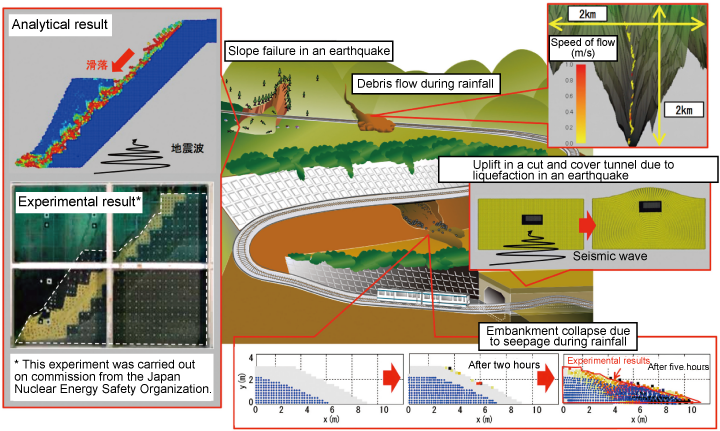5. Meshfree particle method simulation of large ground deformation and collapse behavior
- An analytical tool was developed to assess and predict large ground deformation and collapse.
- This tool can be utilized to analyse slope failure in case of an earthquake and debris flow during rainfall.
Over recent year, a numerical method based on modelization of solid and fluid bodies as a collection of particles (meshfree particle method) has continued to develop, and has been used to analyze the impact of waves on vessels. Nonetheless, this method comes up against certain limits in its application to slope failure, landslides and other types of large ground deformation.
Consequently, in addition to modelization of the ground as particles, strain calculation was carried out using the same approach as the finite element method (FEM) by applying a mesh, in order to devise an analytical tool which permits assessment of large ground deformation and slope failure behavior.
The above method was then combined with publicly available 10m mesh map data into a visualization tool, with a view to building an algorithm which can be used to evaluate landslide behavior over an area extended to a scale of several kilometers.
The applicability of the analytical tool produced was then validated in tests on a debris flow model using dry sand. The outcome of the verification analysis demonstrated that test results showed that accurate assessment was possible.
In addition, results from analysis of debris flow during rainfall, embankment collapse due to seepage, slope failure under seismic motion, uplift in a cut and cover tunnel due to liquefaction, were compared with results of past experiments. This comparison demonstrated that accurate evaluation of large ground deformation and collapse and other ground behavior, which had previously been difficult with the finite element method, was now possible (Fig 1).
 Fig. 1 Meshfree particle method simulation of large ground deformation and collapse behavior
Fig. 1 Meshfree particle method simulation of large ground deformation and collapse behavior